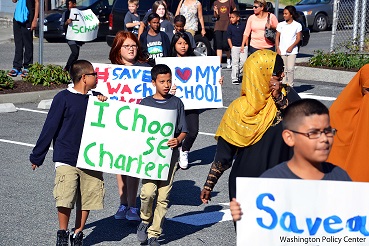Related Articles

In a stunning decision, six justices of the state supreme court ruled last week that Washington’s charter public schools cannot receive public funding because they are not governed by local elected boards. Six justices, citing a 1909 case, found that charter schools are not “common schools.”
According to this reasoning, if charter public schools are unconstitutional, then funding for dozens of similarly-governed education programs, like Innovation Schools, Running Start, vocational prep, online education and Tribal public schools, are also at risk.
Attorney General Bob Ferguson is asking the court to review its ruling. He says the surprising decision “calls into question the constitutionality of a wide range of other state educational programs.”
In an informative analysis in yesterday’s Tacoma News Tribune, former supreme court justice Philip Talmadge questions whether other education programs can meet the court’s new, restrictive definition of “common school” and receive public funding.
Judge Talmadge and Attorney General Ferguson are right. This court decision not only defunds charter schools, it threatens many other highly successful public schools and programs that are governed like charter schools.
To cite one example, Raisbeck Aviation High in Tukwila serves students interested in careers in aviation and aerospace. The school has 400 students, is governed by an independent unelected board, and is recognized as one of the best public high schools in the country.
Here are other education programs, funded by the legislature, which, like charter schools, are not governed by local elected boards:
- Delta High, 400 students, governed by Columbia Basin Community College, WSU, the districts of Pasco, Kennewick and Richland, and private industry.
- TAF Academy, 280 students, governed by the Federal Way district and Technology Access Foundation, a private organization.
- Washington Youth Academy, 140 students, governed by the unelected National Guard, for high-risk students.
- Running Start, 20,000 students, governed by appointed boards of community colleges, technical colleges, four-year universities.
- College in the High School, 19,000 students, governed by appointed boards of community colleges, technical colleges, four-year universities.
- Running Start for the Trades, 2,000 students, governed by appointed boards of community colleges, technical colleges, four-year universities.
- Gateway to College, 579 students, governed by appointed boards of community and technical colleges.
- Tech Prep program, 24,000 students, governed by the unelected federal Office of Vocational and Adult Education.
- Career Link, 600 students, governed by the appointed board of South Seattle Community College.
- Advanced Placement courses, 71,000 students, designed and controlled by the College Board, a private company.
- Jobs for Graduates, governed by a private non-profit organization.
- Skill Centers, 7,000 students, governed by an unelected council of superintendents.
- Career and Technical Education (CTE), for middle and high school students, governed by private advisory boards.
- Online Education, 23,000 students, many courses are governed by private companies.
- Tribal Schools, 1,000 students, governed by unelected Tribal administrators.
The media has already reported on the campaign donations certain justices received from one of the named parties in the charter school case, the WEA union. Now legal experts are questioning the reasoning of the ruling itself.
In contrast to 1909, our modern education system is designed to provide a variety of ways for children to prepare for success in college and in life. That is what voters intended when they passed the charter school law. They wanted to add one more option, especially for families underserved by traditional schools, with an alternative way to access to a quality public education.
The court’s ruling is questionable on legal grounds, and in practical terms it has caused real pain to charter school families. That is why the Attorney General is asking these six supreme court justices to review their decision.
This report is part of WPC's Charter School Follow-Up Project




